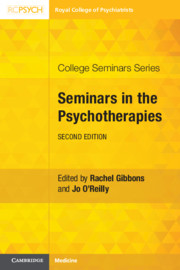Book contents
- Seminars in the Psychotherapies
- College Seminars Series
- Seminars in the Psychotherapies
- Copyright page
- Reviews
- Contents
- Contributors
- Foreword
- Preface
- Part I Therapy Theory and Practice
- Part II Applied Psychotherapeutic Thinking
- Section 1 Psychological and Psychodynamic Approaches to Psychiatry
- Chapter 13 Psychological Approaches to Affective Disorders
- Chapter 14 Psychological Approaches to Psychosis
- Chapter 15 Personality Disorder
- Chapter 16 Complex Post-traumatic Stress Disorder
- Chapter 17 Psychological Approaches to Medically Unexplained Symptoms
- Chapter 18 The Psychodynamics of Self-Harm
- Chapter 19 Psychodynamic Aspects of Suicide and Homicide
- Chapter 20 Forensic Psychotherapy
- Section 2 Work in Practice
- Section 3 Contemporary Developments
- Index
- References
Chapter 13 - Psychological Approaches to Affective Disorders
from Section 1 - Psychological and Psychodynamic Approaches to Psychiatry
Published online by Cambridge University Press: 27 May 2021
- Seminars in the Psychotherapies
- College Seminars Series
- Seminars in the Psychotherapies
- Copyright page
- Reviews
- Contents
- Contributors
- Foreword
- Preface
- Part I Therapy Theory and Practice
- Part II Applied Psychotherapeutic Thinking
- Section 1 Psychological and Psychodynamic Approaches to Psychiatry
- Chapter 13 Psychological Approaches to Affective Disorders
- Chapter 14 Psychological Approaches to Psychosis
- Chapter 15 Personality Disorder
- Chapter 16 Complex Post-traumatic Stress Disorder
- Chapter 17 Psychological Approaches to Medically Unexplained Symptoms
- Chapter 18 The Psychodynamics of Self-Harm
- Chapter 19 Psychodynamic Aspects of Suicide and Homicide
- Chapter 20 Forensic Psychotherapy
- Section 2 Work in Practice
- Section 3 Contemporary Developments
- Index
- References
Summary
The term affective disorders encompasses a range of conditions that affect mood and emotional functioning. It includes unipolar and bipolar disorder as well as anxiety states. This chapter covers the psychodynamic processes involved in depression and anxiety. Key factors that play a role in predisposing, precipitating and perpetuating these conditions are outlined. Along with psychoanalytic theory, the chapter draws on attachment theory and affective neuroscience.
Although psychiatric diagnostic systems classify them separately, there is considerable overlap between anxiety and depression as evidenced in the high levels of concurrent symptoms that are generally seen.
- Type
- Chapter
- Information
- Seminars in the Psychotherapies , pp. 163 - 174Publisher: Cambridge University PressPrint publication year: 2021



